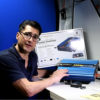Hey guys!
Thanks for checking out my latest video on the WEIZE 12v 100Ah LiFePO4 Deep Cycle Rechargeable Battery.
I’ve completed up to the third part, “A Closer Look” below is an index of the sections available for viewing.
—————–
This Video Contains up to the Open the Box Segment for the full video.
1. Intro (00:00)
2. Open the Box (00:30)
3. A Closer Look (12m16s)
4. Conclusion (Pending)
The Open the Box segment shows me opening the box for the item as it was shipped to me.
I inspect the packaging, item itself, any accessories, and product literature, to include warranty and company information inside the box.
Issues so far is that there was no User Manual, Warranty or Company Information inside the box.
This was very suspicious to say the least, but is consistent with the limited information on the original Amazon listing for the item.
The original listing, as of August 13, 2020, shows the item is no longer available. The listing further removed WEIZE as the seller/shipper for the item.
Not having any user manual, warranty or company information is clearly an ommission of key information inconsistent with traditional reputable business practices which normally include information about the product, and of course, about the company.
I’ll continue to search for information pertaining to the WEIZE battery company. They sell a number of regular batteries and it will be surprising that all of the other boxes did not include their information.
File: 20200623 0943 Weize Open Box Combo 02A Up to Open the Box (03m07s)
* Includes up to Open the Box segment.
(PID: 20200623_0943)






